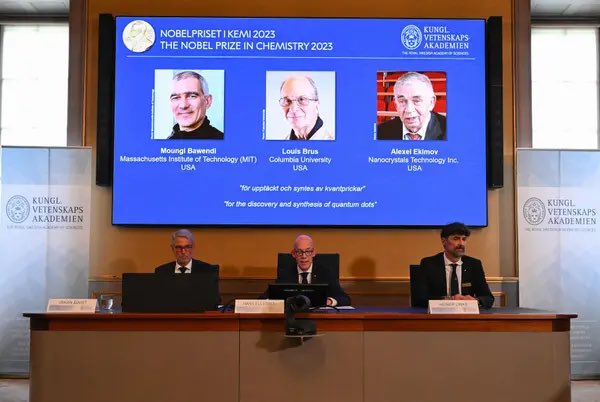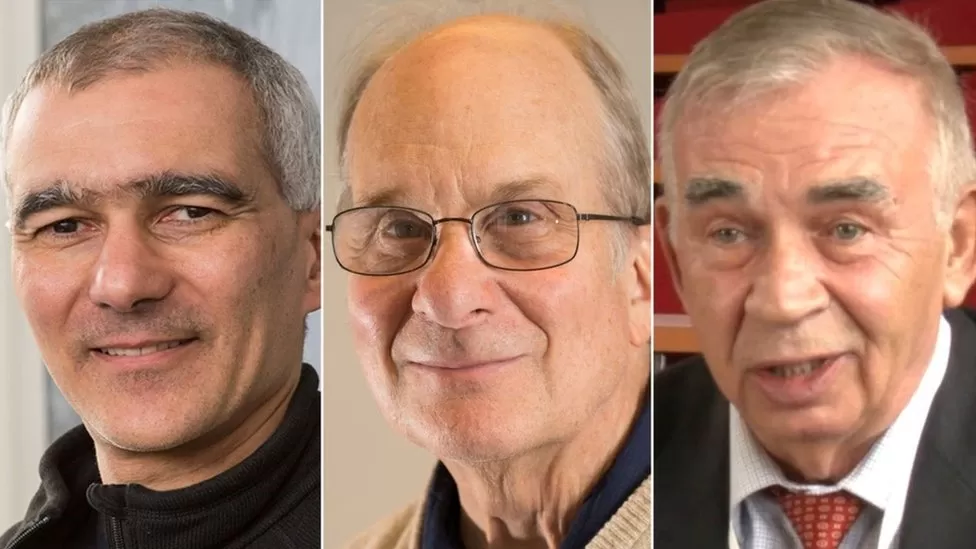“the brilliant world of quantum dots and their Nobel Prize-winning scientists, Moungi G. Bawendi, Louis E. Brus, and Alexei I. Ekimov. Discover how their groundbreaking work is reshaping technology, medicine, and renewable energy, unlocking new possibilities for a vibrant and sustainable future.”
In groundbreaking recognition of scientific achievement, the Nobel Prize for Chemistry has been bestowed upon three brilliant minds: Moungi G. Bawendi, Louis E. Brus, and Alexei I. Ekimov. Their pioneering work in the realm of quantum dots has paved the way for a multitude of applications that impact our daily lives, from the vibrant screens of QLED TVs to advancements in medicine and solar energy.
Quantum dots, minuscule crystals measuring just a few millionths of a millimeter, have emerged as a transformative force in technology and science. These artificially created semiconducting nanoparticles exhibit an astonishing ability to emit vibrant colors—blue, red, or green—when exposed to light. What sets them apart is their size, with each quantum dot producing a distinct color based on its exact dimensions. Smaller quantum dots emit high-energy waves, resulting in brilliant blue hues, while larger ones release lower-energy waves, producing rich red tones, and the intermediate sizes generate the entire spectrum of colors.
Quantum Dots
The journey to harnessing the potential of quantum dots was no easy feat. For years, it was widely believed that creating particles of such diminutive scale was impossible. However, this year’s Nobel laureates shattered this notion with their remarkable contributions to the field.
The story begins with Russian physicist Alexei I. Ekimov, aged 78, who is credited with the initial discovery of quantum dots in the 1980s. This pivotal breakthrough laid the foundation for subsequent advancements in the field. Building upon Ekimov’s work, US chemist Louis E. Brus, aged 80, realized that these crystals could be developed while suspended in a fluid, opening up new avenues for research and application.
Paris-born Moungi G. Bawendi, aged 62, played a crucial role by inventing a method to craft tailor-made quantum dots, significantly expanding their commercial and scientific utility. His contributions were pivotal in pushing the boundaries of what these tiny wonders could achieve.
The impact of quantum dots extends far beyond our TV screens. They are now integral in diverse fields, including medical imaging, enabling surgeons to navigate with precision, and improving the targeting of cancer drugs. In the realm of renewable energy, quantum dots have found a home in solar panels, promising more efficient and compact photovoltaic systems.
The Nobel Prize, accompanied by an award of 11 million Swedish krona (£824,000), is a testament to the immense significance of quantum dots in advancing technology and science. The announcement of the laureates, however, came with an unexpected twist as their names were inadvertently revealed in a press release from Sweden’s Royal Academy of Sciences before the official announcement. Despite this hiccup, the Academy clarified that the final decision on the winners had not been made until just before the official unveiling.
In response to the surprise announcement, Moungi G. Bawendi expressed his feelings of honor and astonishment. “It’s quite an honor,” he remarked, describing himself as “very surprised, sleepy, shocked, and very honored.”
The Royal Swedish Academy of Sciences declared that “quantum dots are thus bringing the greatest benefit to humankind.” Their potential is still unfolding, with researchers envisioning applications in flexible electronics, minuscule sensors, thinner and more efficient solar cells, and encrypted quantum communication. It appears that we have only just begun to explore the vast possibilities offered by these tiny, luminescent particles.

1. Moungi G. Bawendi:
- Background: Moungi G. Bawendi is a distinguished scientist in the realm of quantum dots. Born in Paris, he has earned recognition for his significant contributions to the field.
- Contribution: Bawendi’s pivotal contribution lies in inventing a method for crafting custom-made quantum dots. This breakthrough opened up new possibilities for the commercial and scientific utilization of quantum dots. His work enabled the precise control of quantum dot properties, such as size and composition, leading to their enhanced versatility.
- Impact: Bawendi’s innovation has had a profound impact on various industries. Quantum dots created with his method have found applications in areas ranging from display technology to medicine and renewable energy. His work is a cornerstone in realizing the full potential of quantum dots in practical applications.
2. Louis E. Brus:
- Background: Louis E. Brus is a prominent chemist based in the United States. He has made groundbreaking contributions to the field of quantum dots, particularly in their synthesis and understanding of their properties.
- Contribution: Brus played a critical role in the development of quantum dots by recognizing that these crystals could be effectively created while suspended in a fluid medium. This innovation revolutionized the study of quantum dots by providing a new method for their production and manipulation.
- Impact: Brus’s work laid the foundation for further research into quantum dots, making them more accessible for experimentation and application. His insights have been invaluable in advancing our understanding of quantum dots’ properties and behaviors.
3. Alexei I. Ekimov:
- Background: Alexei I. Ekimov is a distinguished Russian physicist who made groundbreaking discoveries in the field of quantum dots, particularly during the 1980s.
- Contribution: Ekimov is credited with the initial discovery of quantum dots. His work in the 1980s marked the first step towards understanding these tiny crystals and their unique properties. His research sheds light on the quantum confinement effect, which plays a crucial role in determining the properties of quantum dots.
- Impact: Ekimov’s discovery paved the way for subsequent research into quantum dots. His groundbreaking work laid the foundation for the development and exploration of these minuscule crystals, ultimately leading to their practical applications in various industries, including electronics, medicine, and energy.
These three Nobel laureates, Moungi G. Bawendi, Louis E. Brus, and Alexei I. Ekimov, have collectively advanced our understanding of quantum dots and harnessed their potential for real-world applications. Their innovative contributions have left an indelible mark on science and technology, promising a brighter and more colorful future across a wide range of fields.
also read Nobel Prize in Medicine
